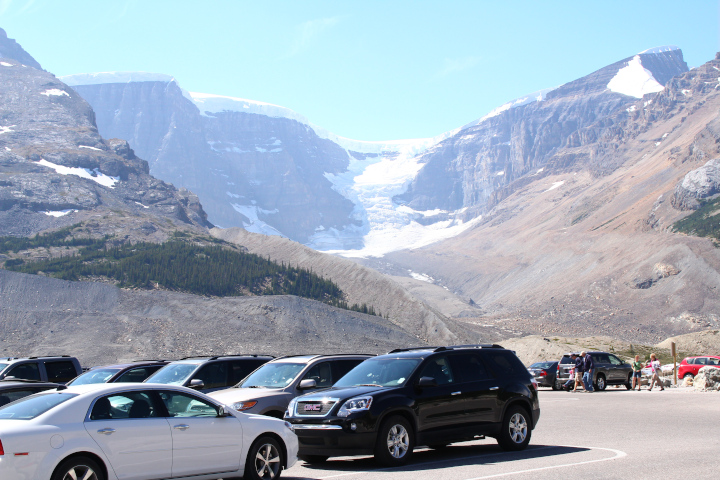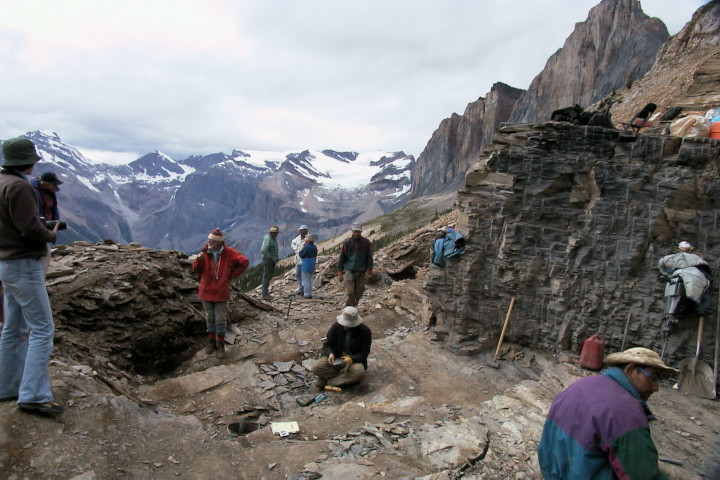
Nature, science, language, values, feral beliefs...
Entries for September 2023

Receding glaciers above meals on wheels for ravens
September 18 , 2023
When A Garage Is Not A Garage
When A Garage Is Not A Garage
This last spring, I opened the side door of
the garage and was surprised to see a Pacific Wren perched in
a corner near the back window. It was also surprising that it
didn't seem particularly upset by my sudden appearance. At
first I thought the little bird had somehow gotten trapped
inside, so I quickly stepped back out and left the door open.
It seemed a bit odd, because the garage hadn't been opened for
several days. Fifteen minutes later I went back to check, and
the wren was gone, so I assumed it had escaped and hoped that
it had not been confined for too long.
A few days later, I opened the same garage door, and there was the wren again, but this time fluttering around by the window. After looking more closely, I could see that there must have been a recent hatching of insects, and they were concentrated against the south-facing glass. For the next week or so, the wren could be seen inside by the window several times a day, apparently coming and going through some unknown small opening somewhere in the structure. Then the insects disappeared, and so did the wren.
How did the bird ever discover the insects inside the garage? Surely it wasn't going around looking for ways into buildings just in case there might be something juicy trapped inside? Had I paid more attention to the wren's scientific name, Troglodytes pacificus, I might have gotten a clue. These troglodyte birds do commonly seek out small openings into crevasses and hollows while looking for food, for nesting, and for shelter from the elements in winter.
That reminded me of some other bird foraging behaviour I have seen: ravens scavaging dead insects in parking lots in Canadian Rocky Mountain National Parks. The birds were going from one vehicle to another in the parking lots, and picking off smashed insects from the front bumpers and grillwork. They seemed to know enough to ignore the rear ends of vehicles, and purposefully marched along the row of front ends, sometimes hopping up to grab the higher morsels.
While both of these feeding strategies struck me as somehow "unnatural" at the time, especially the wren sneaking into the garage via some circuitous route, I now think otherwise. If the inside of a garage seems to me like a strange place for a bird to hang out, or if a parked car seems an odd food source, the birds don't think like that. I can't really know how a wren perceives a garage, but it is unlikely to be the way a human would. When humans try to "make sense" of nature, our (understandable) tendency is to expect it to think like we do - even though we are well aware that even other humans often don't.
A few days later, I opened the same garage door, and there was the wren again, but this time fluttering around by the window. After looking more closely, I could see that there must have been a recent hatching of insects, and they were concentrated against the south-facing glass. For the next week or so, the wren could be seen inside by the window several times a day, apparently coming and going through some unknown small opening somewhere in the structure. Then the insects disappeared, and so did the wren.
How did the bird ever discover the insects inside the garage? Surely it wasn't going around looking for ways into buildings just in case there might be something juicy trapped inside? Had I paid more attention to the wren's scientific name, Troglodytes pacificus, I might have gotten a clue. These troglodyte birds do commonly seek out small openings into crevasses and hollows while looking for food, for nesting, and for shelter from the elements in winter.
That reminded me of some other bird foraging behaviour I have seen: ravens scavaging dead insects in parking lots in Canadian Rocky Mountain National Parks. The birds were going from one vehicle to another in the parking lots, and picking off smashed insects from the front bumpers and grillwork. They seemed to know enough to ignore the rear ends of vehicles, and purposefully marched along the row of front ends, sometimes hopping up to grab the higher morsels.
While both of these feeding strategies struck me as somehow "unnatural" at the time, especially the wren sneaking into the garage via some circuitous route, I now think otherwise. If the inside of a garage seems to me like a strange place for a bird to hang out, or if a parked car seems an odd food source, the birds don't think like that. I can't really know how a wren perceives a garage, but it is unlikely to be the way a human would. When humans try to "make sense" of nature, our (understandable) tendency is to expect it to think like we do - even though we are well aware that even other humans often don't.

September 11 , 2023
How Can We Know What We Know?
How Can We Know What We Know?
Last week I looked at potential misunderstanding caused by an uncritical reading of a metaphorical narrative: a symbolic "Car Crash". Such a reading might lead you to think you know, or understand, something that you really don't.
Humans are able to know things through scientific inquiry. A commonly held erroneous assumption is that science discovers "Truths". This leads to many people getting upset when scientists seem to be "wrong" about something. Science is actually an on-going process that tests assumptions, gathers and evaluates evidence, and where necessary revises and refines prior understanding. It provides the best available picture of reality at any given moment. But of course most people are not scientists, and no one scientist can be fully informed about many other fields of study.
The photo above was taken at the Walcott Quarry of the Burgess Shale high in the Canadian Rockies in the summer of the year 2000. The rocks in the Burgess Shale contain 500 million-year-old fossils that have been collected and studied, and reassessed, and reinterpreted, for more than a century. These Cambrian Period fossils are particularly revealing because they show rarely preserved soft tissues of many strange marine organisms. Paleontologist and evolutionary theorist Stephen J. Gould wrote a popular book, Wonderful Life, about those fossils and his ideas of their evolutionary implications back in 1986. Since then, other scientists who have studied the fossils have disagreed with some of Gould's conclusions. A clearer picture of the significance of the Burgess Shale fossils has gradually developed over time.
Not everyone can be a paleontologist with enough experience to interpret the fossil record competently. Not everyone can be an astrophysicist, or an epidemiologist. We know that many, many scientists engage in years of study attempting to discover more evidence to support a more complete understanding of nature and reality. We benefit from, and sometimes suffer the consequences of, many of these discoveries. The result of all of this scientific effort is that anyone can know there were strange creatures living in the oceans 500 million years ago even without being a trained paleontologist, just as anyone can know that the planet Jupiter orbits the sun beyond the orbit of Mars without being an astronomer.
Without tested evidence that can be evaluated in the context of previous discoveries, and which then helps to provide a coherent explanation for multiple observations of reality, we have only speculation, or worse. Sometimes that evidence can be found on the tops of mountains far from its oceanic origins. Yes, experts can have differences of opinion, but over time, continued study can sort out those differences. At that point it makes sense to say that we know something.

September 4 , 2023
The Price of Oversimplification Is Underestimated
The Price of Oversimplification Is Underestimated
Here are some second thoughts about last
weeks "car crash" narrative. Many complex, alarming situations
can be referred to, simply, as "Car Crashes". But do such
metaphors really help us to think carefully? Or do they just
make it easier to "move on" more quickly?
One feature of metaphors is a capacity to compress details into an ultra simplified package, and represent them as something that might appear to be more familiar. This extreme simplification of reality can be as misleading as it is attractive, partly because it helps to create an illusion of understanding despite real uncertainty. We could think and communicate without metaphors, but that would require serious changes.
In the "Car Crash" metaphorical narrative from last week, for example, what might "The Car" symbolise? Humanity failing to confront a political crisis? An ecological disaster? The climate emergency? Human overshoot? All of the above? That would be a lot. The bleak picture conjured by the narrative fails to account for the complexity of any of these possibilities, even as it implies a summary judgement on our chances of avoiding disaster. If the bleakness encourages disengagement with a crisis, that becomes self-defeating.
Composed of stereotypical characters, this particular narrative offers a dark prognosis with nothing substantive in the way of evidence. Instead it offers a supporting cartoonish cast representing hyper-simplified "types", each of which engages in a selected negative behaviour. The combination is a fabulous worst-case stew. The intricacies of actual people, and certainly of an actual crisis, could not properly be reduced to such terms. The metaphorical treatment does not contribute anything useful toward a more complete understanding of the situation.
It is possible to see, or think, "Aha, Car Crash", and then "move on". It is not really possible to "move on" from reality.
One feature of metaphors is a capacity to compress details into an ultra simplified package, and represent them as something that might appear to be more familiar. This extreme simplification of reality can be as misleading as it is attractive, partly because it helps to create an illusion of understanding despite real uncertainty. We could think and communicate without metaphors, but that would require serious changes.
In the "Car Crash" metaphorical narrative from last week, for example, what might "The Car" symbolise? Humanity failing to confront a political crisis? An ecological disaster? The climate emergency? Human overshoot? All of the above? That would be a lot. The bleak picture conjured by the narrative fails to account for the complexity of any of these possibilities, even as it implies a summary judgement on our chances of avoiding disaster. If the bleakness encourages disengagement with a crisis, that becomes self-defeating.
Composed of stereotypical characters, this particular narrative offers a dark prognosis with nothing substantive in the way of evidence. Instead it offers a supporting cartoonish cast representing hyper-simplified "types", each of which engages in a selected negative behaviour. The combination is a fabulous worst-case stew. The intricacies of actual people, and certainly of an actual crisis, could not properly be reduced to such terms. The metaphorical treatment does not contribute anything useful toward a more complete understanding of the situation.
It is possible to see, or think, "Aha, Car Crash", and then "move on". It is not really possible to "move on" from reality.